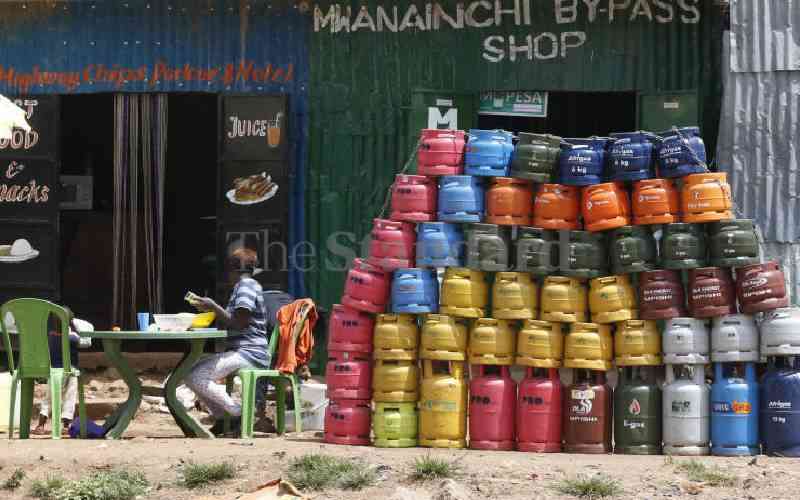
The sudden pressure by banks to have the law capping interest rates scrapped has put the Government in a tight spot.
The big question is whether the Government should discard a regulation that was supposed to increase access to credit but has instead resulted in the opposite just six months since President Uhuru Kenyatta signed it. The banking industry is facing a moment of truth as tough regulations introduced by the Central Bank of Kenya (CBK) which took effect last year and a limit on how much lenders can charge as interest, have come full circle.
Most of the lenders have released their 2016 full-year financial results and there is a significant dip in profits for some of them. Now, they are using their sudden change of fortunes to arm-twist the Government into doing away with the law that caps rates at 4 per cent above Central Bank rate.
All eyes are now on Treasury Cabinet Secretary Henry Rotich who is expected to give the Government’s position on the matter on Thursday when he delivers the budget. But whichever decision the technocrats at Treasury and the Government make, the effects will have both economic and political repercussions. Economists have argued that the rate cap law may have been responsible for lower GDP growth at the end of last year while banks blame it for their dwindling profits.
Reporting prudently
However, reversing the law which was very popular with Kenyans when it was signed in August last year will expose the country to exploitative interest rates once again, which brings a political angle to the matter. Banks are, however, adamant the law must be discarded.
“The solution is not to tweak the law, but to remove it and consider some proposals to make credit accessible. We know these problems and we are trying to address them,” Kenya Bankers Association Chief Executive Habil Olaka says. Nevertheless, he says the reason there is a drastic change in their financial numbers is because some banks have not been reporting prudently in the past and that gave a rosy impression of the whole sector.
While responding to allegations that he (Mr Olaka) had given a secret memo to bank bosses to blame all their misfortunes on the rate cap, the KBA boss said he had only instructed bank CEOs to stop cooking their books. “It is not in KBA’s position to give advice on how to report their numbers. The numbers are generated by the banks themselves, they are the ones who can give meaning to the numbers,” he says.
“What we are trying to advise banks, there could be a tendency to try to couch the numbers in a way that the true information does not come out.”
During his State of the Nation address two weeks ago, President Kenyatta expressed his frustration at the negative effects of the interest rates law. “Our SMEs are complaining that they do not have access to credit in spite of the fact that the cost of credit in Kenya is the most affordable in the region after the capping of commercial bank interest rates in September last year,” he said.
This gave a hint that the Government may be working on new policy guidelines but appear keen to have a new regulation that is in their favour. The interest rate cap limits commercial bank lending rates at 400 basis points or 4 per cent above the Central Bank rate, which currently stands at 10 per cent.
This, plus a regulatory directive by the CBK issued in 2015 that forced banks to set aside money for Non-Performing Loans (NPL) from their profits has resulted in a tighter operation environment which has had an effect on the performance of the sector.
Last year, total NPLs in the industry reached record levels with the volume of bad loans growing by 9.1 per cent of the Sh2.28 trillion loan book as at September 2016 compared to 8.4 per cent in June, according to data from CBK.
Total stock of bad debt for the 43 lenders was at Sh214 billion by November last year, the highest in Kenya’s history, as growth in credit dropped from 16.8 per cent in January 2016 to 4.3 per cent in December. The outcome is now evident in what is contained in the financial results of the banks that have so far released theirs.
Equity Bank, which is the biggest lender in terms of customer numbers and widely seen as the standard measure of Kenya’s successful banking sector, reported a dip in profits for the first time in a decade, raising fears that the industry is facing tough times.
The lender, which reported a four percent dip in its full year profit to Sh16.6 billion attributed the drop in profitability to interest capping and slow growth in its regional subsidiaries.
NIC Bank recorded a 3.4 per cent decline in net profit to post Sh4.3 billion while Barclays Bank of Kenya’s net profit fell to Sh7.1 billion from Sh8.4 billion.
Stanbic Bank recorded a Sh4.4 billion net profit for the year, down from Sh4.9 billion in 2015 and blamed it on bad loans which went up from Sh4.8 billion to Sh7 billion. This forced the bank to allocate a provision of Sh1.7 billion as an impairment cost.
“Net NPLs have increased by Sh1.6 billion mainly in the manufacturing, trade and agriculture sectors,” Stanbic Bank’s Chief Finance Officer Abraham Ongenge said.
Experts say this was expected. “The introduction of the interest cap and the floor was the catalyst for a Darwinian moment in the banking sector. The Tier 1 banks were beneficiaries of a flight to quality of which StanChart was the biggest beneficiary,” says Aly Khan Satchu, the Chief Executive at Rich Management.
It is StanChart that surprised the market with double digit growth. The lender, whose results were released on Thursday made a 45 percent jump in net profit from Sh6.3 billion to Sh9 billion on the back of increased lending to the Government and lower cost of covering for bad loans. This was, however, merely a readjustment since the lender reported a 39 per cent drop in profit in 2015.
Kenya Commercial Bank (KCB), the country’s largest bank by assets, saw its net profit grow by 0.5 per cent in its 2016 full-year earnings to Sh19.72 billion, the slowest growth in seven years. Co-operative Bank of Kenya also made an 8.2 per cent jump in profit after tax to Sh12.6 billion from Sh11.7 billion the year before.
Satchu observes: “Tier 3 banks in their old format are now “zombies” unless shareholders dig deep and pony up capital or get bought out.
“This Act is not going to work and it has not. We need to move quickly and effectively to reverse it because credit is the lifeblood of this economy and no Government chooses to walk into an election with an economy in a recession.”
Last year, I&M Bank bought Giro Bank for Sh5.7 billion while Diamond Trust Bank (DTB) announced this week its intention to acquire Habib Bank for Sh1.8 billion.
Also, the banks are expected to come under more pressure with the new set of global accounting rules which require financial institutions to make higher loan-loss provisions become applicable in 2018.
The new guidelines, International Financial Reporting Standard (IFRS) 9, will come into force on January 1, 2018 and will adopt a one-year forward-looking model rather than waiting for loans to go sour to make provisions like under the current regime known as International Accounting Standards (IAS) 39.
Barclays Bank of Kenya, which has already implemented the system says it is part of the reason it recorded a profit drop.
“The growth in impairment was also driven by the early adoption of some aspects of the more conservative global accounting model referred to as International Financial Reporting Standard (IFRS) 9,” it said in a statement while announcing its results last month.
Banks have already received critical backing from the International Monetary Fund (IMF) which has said interest controls had also complicated monetary policy and threatened the survival of small banks. The Consumers Federation of Kenya, however, says the bad state of Kenya’s banking sector is as a result of failed IMF policies in the first place.
“While IMF is quick to call for removal of caps on interest rates, it turns a blind eye to the reason the capping was necessitated,” it said through its Secretary General Stephen Mutoro.
Kiambu Constituency Member of Parliament Jude Njomo who sponsored the Bill that capped interest rates has accused banks of economic sabotage. “I don’t see why they should have their cake and eat it. Members of Parliament will not agree when the matter comes to the floor,” he says.
“What we need to do is encourage the Government to borrow less so that banks will have money at their disposal to lend to Kenyans. Otherwise I am seeing a situation where a small bank will start offering lower interest rates than all of them and it will win big,” he adds.
In the last quarter of 2015, heavy borrowing by the Government from banks at 20 percent interest rate, made banks to lend to their customers at a rate of between 24 and 28 per cent pushing the cost of credit to unaffordable levels.
Reversed this decision
And because of the good returns banks get from cash loaned to the Government, most of them started denying individuals and companies money for development and other expenditures and opted for the high-yielding T-Bills and Bonds that are risk-free and easy to manage.
This ignited the crisis that eventually led to the Government introducing the current interest rate caps as a solution to a problem it is accused of starting.
At least 20 other African countries have attempted to cap their interest rates but some like Zambia reversed this decision.
 The Standard Group Plc is a multi-media organization with investments in media
platforms spanning newspaper print operations, television, radio broadcasting,
digital and online services. The Standard Group is recognized as a leading
multi-media house in Kenya with a key influence in matters of national and
international interest.
The Standard Group Plc is a multi-media organization with investments in media
platforms spanning newspaper print operations, television, radio broadcasting,
digital and online services. The Standard Group is recognized as a leading
multi-media house in Kenya with a key influence in matters of national and
international interest.
 The Standard Group Plc is a multi-media organization with investments in media
platforms spanning newspaper print operations, television, radio broadcasting,
digital and online services. The Standard Group is recognized as a leading
multi-media house in Kenya with a key influence in matters of national and
international interest.
The Standard Group Plc is a multi-media organization with investments in media
platforms spanning newspaper print operations, television, radio broadcasting,
digital and online services. The Standard Group is recognized as a leading
multi-media house in Kenya with a key influence in matters of national and
international interest.










